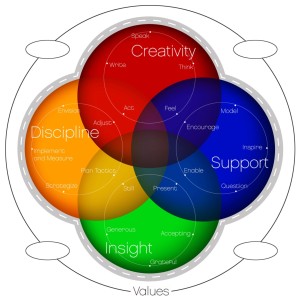The concept of creativity is often connected to innovation and imagination, or the ability to construct a new form or mental picture. This gift of creativity is bestowed on a limited few. And while businesses benefit greatly from the talents of those extraordinary individuals who consistently demonstrate an ability to think of new things, companies also benefit greatly when a more unconventional type of creativity is practiced. The good news is, this powerful form of creativity can be learned.
Unconventional creativity is actually based on the root word create and is defined as the ability to manifest the future. Unconventional creativity offers every individual in your organization a powerful tool to dramatically increase the probability of your company’s success.
Creativity can be internal and/or external. Internal creativity occurs when an individual thinks and feels. External creativity occurs when a person speaks, writes or acts. Here is more on these four powerful ways to practice unconventional creativity:
Inside out – Feelings provide a great window into your unique and personal truth. Your feelings are expressed through an accurate personal barometer—your body. Your body does not mislead you. When you choose to trust your instincts, intuition, and “gut feelings,” you learn that you are perceptive. When you choose to listen to your sixth sense, you align the creative process with your personal truth. Decision making is an everyday occurrence in business, and often involves a precise and measured method. But failing to take into account your gut feeling on decisions—especially big ones—is a mistake.
Also part of inside-out creativity, active thinking is the conscious awareness of the creative process. You can choose to manage your thoughts. You have the ability to change negative patterns when you first become aware of them. Train yourself to use optimistic future scenarios, while focusing on the positive nature of what is happening now, to build energy that can help you create your future and the future of your organization.
Speak your mind – Spoken words have inspired and incited. Speeches have always been an effective tool to influence people. Relationships can be strengthened or weakened based on the care used with the spoken word. Choose to select your words carefully, acknowledging the energy behind the important practice of verbal communication and the impact words have on the future you are creating.
Power of the pen – People have long understood the power of the pen as a creative force to influence others. The energy created by the written word to influence others, and its impact on life, is indisputable. Examples include the Tao Te Ching, the Koran, and the Bible. Your written word, whether email, memo, or a formal report, has the power to determine the direction of your future. Less well understood is the power of the written word to positively influence your own behavior and to create your own future. When you write your goals, you increase the probability of reaching those goals with the energy created by writing them. Similarly, when you write your fears and concerns, you release the hold those negative emotions can have.
Fake it ‘til you make it – How you act offers the most visible form of creation. Conscious action often builds on the feelings, thoughts, speech, and written energy that precede it. You are held accountable for your actions more than you are for the other forms of your ability to create. Action is powerful. When you are having trouble creating the future you want, you can choose to simply act the part and the feelings, thoughts, and words will follow. Do you know people who seem to have “tailwinds” that help move them along in everything they do? When you act in a fashion synchronized with who you truly are, you will find that things seem to happen more easily for you, too.
Author Frank Outlaw offers a reminder of the interconnectedness of these powerful creativity tools with a powerful poem:
Watch your thoughts they become your words,
Watch your words they become your actions,
Watch your actions they become your habits,
Watch your habits they become your character,
Watch your character it will become your destiny.
In summary, you are a Chief when you use your thoughts, feelings, words, and actions—each in alignment with the others—to create a new path forward, which will be recognized by others for its congruence and its vision. As a Chief with this kind of vision, you will be a true leader. The power in this type of nonconventional creativity cannot be understated. Every person in your organization can use this type of creativity to manifest a better future for your company.
This is the third of a series of five blogs about the All-In Roadmap elements:
Unconventional Discipline
Unconventional Support
Unconventional Insight
Unconventional Values
